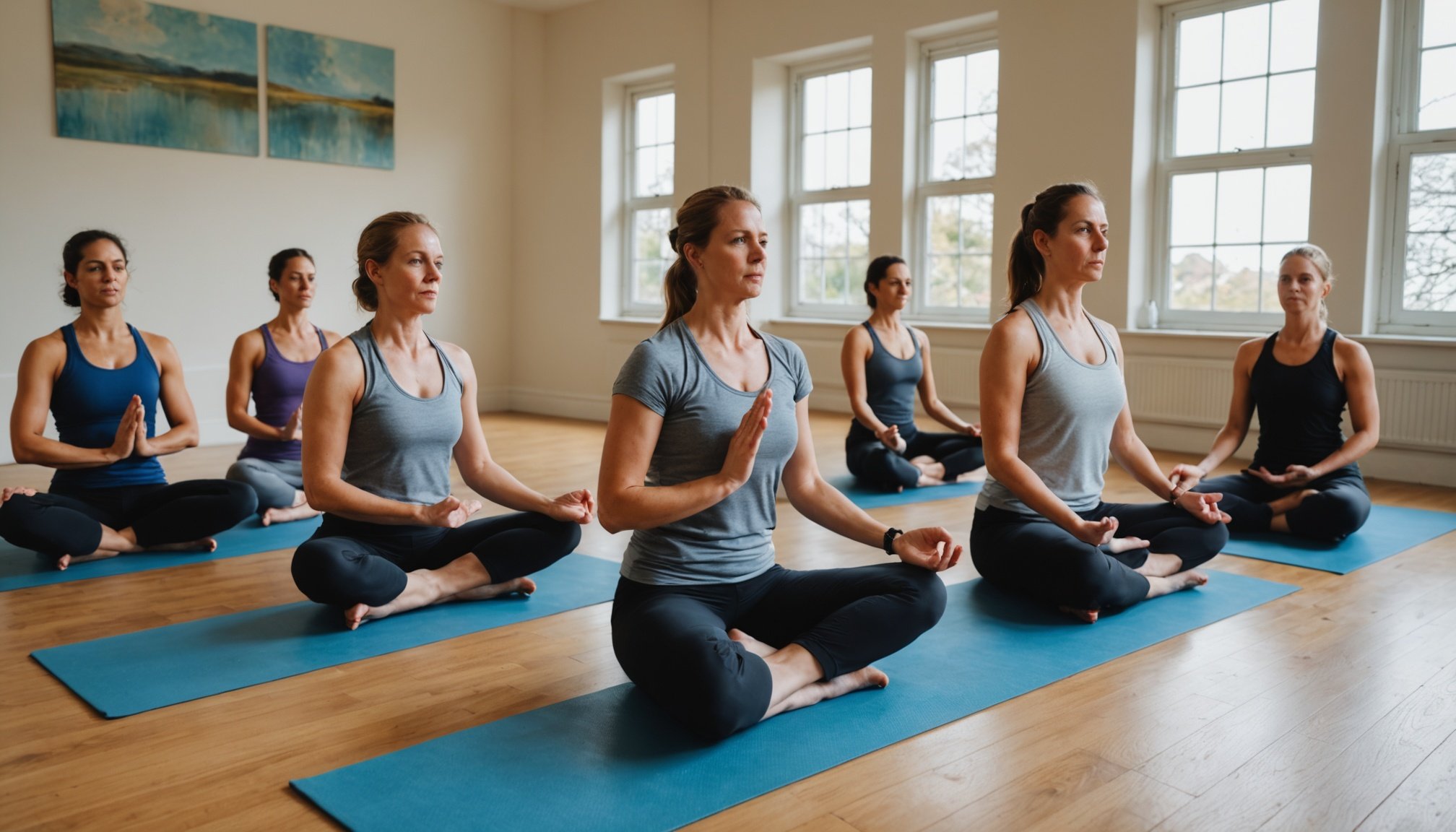Unlocking the Advantages of Consistent Yoga Practice for Educators in the UK
The Stressful Life of Educators
Teaching is one of the most rewarding yet stressful professions. Educators in the UK, like their counterparts worldwide, face a myriad of challenges that can impact their physical and mental well-being. From managing classrooms and developing lesson plans to dealing with administrative tasks and supporting students’ emotional needs, the job of a teacher is multifaceted and demanding. This is where yoga can play a significant role in helping educators maintain their health and performance.
How Yoga Can Help
Yoga is more than just a physical practice; it is a holistic approach that integrates the body, mind, and spirit. Here are some ways yoga can benefit educators:
Additional reading : Ultimate Guide to Safe High-Intensity Interval Training for UK Adults: Tips and Techniques
Physical Health
Yoga helps in improving flexibility, balance, and strength. Regular practice can reduce chronic pain, improve posture, and enhance overall physical fitness. For teachers who spend long hours standing or sitting, yoga can be particularly beneficial in alleviating back pain and other musculoskeletal issues.
Mental Clarity and Stress Reduction
Yoga is renowned for its ability to reduce stress and anxiety. Through various techniques such as breathwork, meditation, and physical postures, yoga helps in calming the mind and improving mental clarity. This is crucial for educators who need to stay focused and composed, even in the most challenging situations.
Topic to read : Unlocking the Advantages: Why Interval Walking Should Be a Key Part of Your UK Fitness Routine
Emotional Well-being
Yoga fosters emotional well-being by teaching practitioners to be more aware of their emotions and thoughts. It helps in developing emotional resilience, which is essential for managing the emotional demands of teaching. By practicing yoga, educators can better handle the pressures of their job and maintain a positive outlook.
Incorporating Yoga into Daily Life
Starting Small
For those new to yoga, starting with short daily practices can be incredibly beneficial. Here are some tips to get you started:
- Begin with short sessions: Start with 10-15 minute practices each day. This could be as simple as doing some basic stretches or following a short yoga video.
- Find a quiet space: Identify a quiet, comfortable space at home or school where you can practice without distractions.
- Use online resources: There are numerous online classes and videos available that cater to different levels of practice. Websites like YouTube and specialized yoga apps can be great resources.
Joining Yoga Classes
Joining yoga classes can provide a structured environment and the guidance of a qualified yoga teacher. Here are some advantages of joining classes:
- Guided Practice: A yoga teacher can help you learn proper techniques, correct any mistakes, and provide modifications suitable for your level.
- Community Support: Practicing with others can be motivating and help you feel part of a community.
- Variety: Classes often offer different styles of yoga, such as Hatha, Vinyasa, or Power Yoga, allowing you to find what suits you best.
Benefits for Teachers and Students
Improved Classroom Environment
When teachers practice yoga, they can create a more positive and calm classroom environment. Here’s how:
- Better Classroom Management: Teachers who practice yoga tend to be more patient and composed, which can lead to better classroom management.
- Enhanced Student Engagement: A calm and focused teacher can engage students more effectively, leading to improved learning outcomes.
Role Modeling Healthy Habits
Teachers who practice yoga can serve as role models for their students, promoting healthy habits and a balanced lifestyle.
### Table: Benefits of Yoga for Educators
| Benefit | Description |
|
|-----------------------------------------------------------------------------|
| **Physical Health** | Improves flexibility, balance, and strength; reduces chronic pain. |
| **Mental Clarity** | Enhances focus and mental clarity; reduces stress and anxiety. |
| **Emotional Well-being** | Fosters emotional resilience; improves emotional awareness. |
| **Classroom Environment** | Creates a more positive and calm classroom environment. |
| **Student Engagement** | Enhances student engagement through better classroom management. |
| **Role Modeling** | Promotes healthy habits and a balanced lifestyle among students. |
Practical Insights and Actionable Advice
Creating a Home Practice
Creating a home practice can be as simple as setting aside a dedicated space and committing to a regular routine. Here are some tips:
- Invest in a Good Yoga Mat: A good yoga mat can provide the necessary grip and comfort for your practice.
- Follow Online Classes: Use online classes or videos to guide your practice, especially if you are new to yoga.
- Be Consistent: Aim to practice at the same time every day to make it a habit.
Attending Yoga Retreats
Yoga retreats can be a wonderful way to deepen your practice and rejuvenate. Here’s what you can expect:
- Immersive Experience: Retreats offer an immersive yoga experience with multiple classes and workshops.
- Community Building: You get to connect with other yoga practitioners and build a community.
- Relaxation and Rejuvenation: Retreats often include other wellness activities like meditation, hiking, and healthy eating.
Quotes from Educators Who Practice Yoga
- “Yoga has been a game-changer for me. It helps me stay focused and calm, even on the most chaotic days.” – Sarah Johnson, High School Teacher
- “Practicing yoga has improved my overall well-being. I feel more energized and better equipped to handle the demands of teaching.” – Mark Davis, Elementary School Teacher
- “Yoga has taught me how to breathe and stay present, which is invaluable in the classroom. My students notice the difference too.” – Emily Thompson, Middle School Teacher
Building a Yoga Community Among Educators
Starting a School Yoga Group
Starting a yoga group at school can be a great way to build a community of like-minded educators. Here’s how you can do it:
- Find Interested Colleagues: Talk to your colleagues about starting a yoga group and see who is interested.
- Identify a Space: Find a suitable space at school where you can practice yoga.
- Schedule Regular Sessions: Decide on a regular time and day for the group to meet.
Collaborating with Local Yoga Studios
Local yoga studios can be a valuable resource for educators. Here’s how you can collaborate with them:
- Discounts for Educators: Many studios offer discounts for educators or special packages for groups.
- Workshops and Seminars: Studios often host workshops and seminars that can be beneficial for educators.
- Teacher Training Programs: Some studios offer teacher training programs that can help educators learn how to teach yoga to their students.
Consistent yoga practice can be a powerful tool for educators in the UK, offering numerous benefits that extend beyond the physical realm. By incorporating yoga into their daily lives, educators can improve their mental clarity, reduce stress, and create a more positive classroom environment. Whether through home practice, joining classes, or attending retreats, yoga provides a holistic approach to well-being that is essential for the demanding role of teaching.
In the words of B.K.S. Iyengar, “Yoga allows you to find a new kind of freedom that you may not have known you had. You can experience a sense of liberation, of release, of letting go of the burdens of the past and the anxieties of the future.”
By embracing yoga, educators can not only enhance their own lives but also positively impact the lives of their students, creating a healthier, happier, and more balanced educational community.











